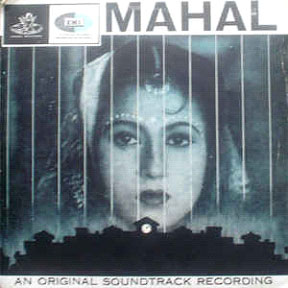 Mahal – Khemchand Prakash
Mahal – Khemchand Prakash
One look at the cover of this 45 RPM Vinyl and you know that there is mystery inside. There is a sketched silhouette of a palace (Mahal) with a clock tower (showing 2 o’clock), over which hovers the beautiful and mysterious face of Madhubala. And the dark hues convey its night-time.
Put Side 1 of the little record for a spin and the first sound that comes is that of the clock tower striking two. Then comes a pause after which Lata Mangeshkar, starts on a slow, instrument-less solo of the iconic Aayega Aanewala.
The song has two parts to it. In the first part, as per the script’s demand, Lata’s voice was supposed to sound like it was coming from a distance. Khemchand Prakash, the visionary music director asked her to stand away from the microphone and walk towards it as she sang the opening line so that she was at the mike when the second part started (It is said that it took several rehearsals to achieve this effect).
And then, the second part comes in with its rich orchestration and the great hook made out of two words Mukhda (beginning of a song), probably the shortest in Hindi Film history. As the song proceeds into the melodic meanderings, it unravels its mystery and impeccably crafted, rich instrumental nuances. The song made Lata Mangeshkar a household name across the country.
Side 2 of the record has two other gems Dil Ne Phir Yaad Kiya by Lata again and Ghabra Ke Jo Hum Sar Ko by Rajkumari. Lyrics of all the songs were written by Nakshab Jarchvi.
The vinyl is of historical significance for the music industry. Before Mahal, records listed character names and the first batch of records credited Aayega Aanewala to Kamini, the character played by Madhubala. When the song first played on All India Radio, its phone lines were flooded with callers inquiring the singer's name. All India Radio had to find this out from the record company before it could announce Lata Mangeshkar's name on the air. Henceforth, playback singers started getting their dues on the records.
Finally, coming to the musical genius of Khemchandra Prakash. The man who lit briefly but very brightly on the Hindi Film Industry, producing gems like Ziddi, Tansen and Mahal. The man who shaped the future course of music in the industry. The man who mentored the likes of Naushad and Anil Biswas to an extent. The man who gave Kishore Kumar and Lata Mangeshkar to India. And, Mahal became the swan-song for this man. He was all of 42 when he died.
On a personal note, the song always takes me back to the mornings of my childhood days. My Father would be playing Radio Ceylon, while I’d be getting ready for the school. Amidst the rush, the song would come on the station and I’d start humming it. Sometimes, the humming would continue all the way up to the school.
Year: 1949
Genre: Hindi Film
Music Label: EMI
Rating: 5/5
Reviewed By Meraj Hasan
Meraj Hasan is a Mumbai based communication professional (and an amateur poet / musician) with a passion for listening to music the vinyl way. His 26 year old Technics turntable along with a humble collection of LPs across genres like Classic Rock, Jazz, Blues, and Classical, amongst others are his prized possessions.
